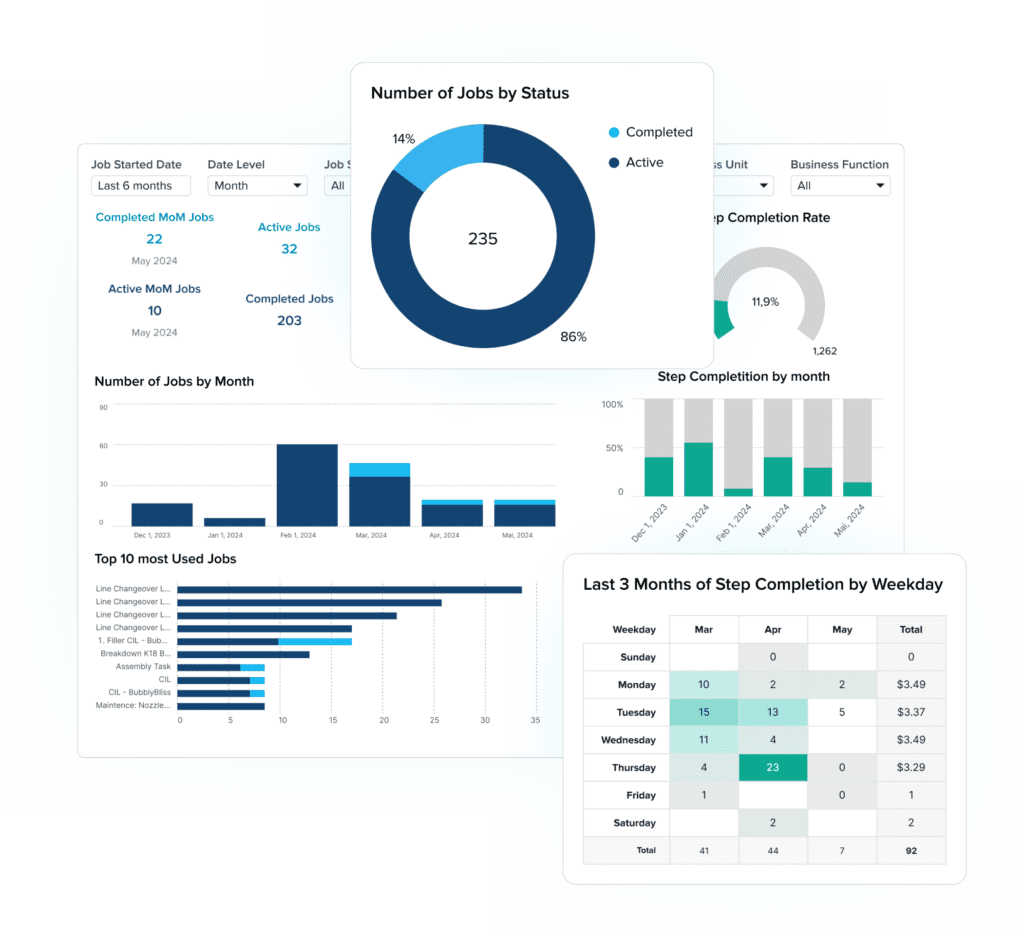From Data Chaos to Clarity: Overcoming Common Pain Points in Frontline Analytics
Many modern manufacturers find themselves being “data-rich, insight-poor” due to the complex nature of capturing data and deriving insights in the manufacturing space. While intuition plays a role in decision-making, relying solely on it without leveraging data leads to suboptimal outcomes.
Data-driven decision-making (DDDM) enables businesses to verify and quantify their decisions, leading to more confident and proactive strategies. However, having the data is only the first hurdle. How manufacturers ingest, analyze, and act on the data is just as important as the curation. In the age of Industry 4.0, It’s important to understand the role data analytics and reporting play within the manufacturing space, along with the challenges and benefits of adopting modern-day analytics tooling.
In this blog post we will highlight:
- Data Analytics with Modern Manufacturing
- The benefits of data analysis
- Challenges in Data Analysis for the Frontline Worker
- Hidden complexities of modern Business Intelligence tools within the Manufacturing space.
- Importance of ensuring accuracy and integrity of data
- How Parsable’s AI-Powered Analytics is revolutionizing frontline operations & democratizing data and insights for all, via easy-to-use, yet highly customizable Analytics & Reporting functionality.
Data Analytics: The Backbone of Modern Manufacturing
Data Analytics involves examining large sets of data to uncover hidden patterns, correlations, and insights. It involves using different methods and tools to work with data and turning raw data into useful information that can help make decisions. This process can include methods like statistical analysis, machine learning, and data mining. The main goal of data analytics is to improve business outcomes by providing actionable insights.
Data Reporting organizes data into summaries or visual formats such as charts, graphs, and dashboards. This makes complex data easier to understand and interpret, allowing stakeholders to quickly grasp key information and trends. Reporting is often an integral part of data analytics, as it communicates the results of data analysis to decision-makers in a clear and concise manner.
In manufacturing, data analytics is crucial for optimizing processes, reducing waste, and improving product quality. By leveraging data effectively, manufacturers can identify patterns and trends that help in predictive maintenance, supply chain optimization, and enhancing overall operational efficiency. The importance of data-driven decision-making in manufacturing cannot be overstated, as it allows for proactive management and continuous improvement.
Implementing data analytics in manufacturing leads to several key benefits:
1. Improved Decision-Making
Data-driven decision-making significantly reduces reliance on guesswork and intuition. By leveraging data analytics, organizations can access actionable insights derived from vast amounts of data.
These insights enable more informed and effective decisions across various business functions. For instance, businesses can analyze customer behavior, market trends, and internal performance metrics to make strategic decisions that align with their goals. Data analytics finds hidden patterns and connections for more accurate predictions and outcomes than traditional methods.
2. Risk Mitigation
Predictive analytics is essential for identifying potential risks and providing early warnings, enabling organizations to take proactive measures to mitigate these risks. This capability is especially crucial in industries where timely risk identification can prevent significant losses and enhance safety. In manufacturing, it can predict equipment failures and quality issues, allowing for preventive actions to avoid costly disruptions
3. Operational Efficiency
Data analytics plays a crucial role in enhancing operational efficiency by identifying inefficiencies and optimizing processes. By analyzing production data, logistics, and supply chain operations, organizations can pinpoint bottlenecks and areas for improvement.
For example, predictive maintenance can forecast equipment failures, allowing for timely repairs and minimizing downtime. This not only improves productivity but also results in significant cost savings. Additionally, real-time analytics enables businesses to adjust operations on-the-fly, ensuring that resources are utilized efficiently and effectively.
4. Competitive Advantage
Organizations that effectively utilize data analytics gain a competitive edge by better understanding market dynamics, customer preferences, and internal performance metrics. This deeper insight enables companies to respond quickly to market changes and customer needs, staying ahead of competitors. Data analytics helps businesses identify emerging trends, new market opportunities, and potential threats, allowing them to adapt their strategies proactively. This agility and foresight are critical in maintaining a competitive position in the market.
Data analytics is indispensable for modern enterprises, providing numerous benefits that enhance decision-making, operational efficiency, customer experience, and risk management. By leveraging data analytics, organizations can gain valuable insights that drive strategic initiatives, improve performance, and maintain a competitive edge in a rapidly evolving business landscape. Real-time data processing capabilities are crucial for immediate decision-making, allowing manufacturers to respond quickly to changes and maintain optimal operational conditions.
Frontline Operations: Challenges in Data Analysis
Historically, having a “pulse” on data has been a significant pain point for the modern manufacturer. Manufacturers spend billions on frontline workers, yet they are entirely blind to what’s working and what’s not.
Frontline workers in manufacturing face several data analysis challenges, with data overload and information silos being primary issues. The sheer volume of data can overwhelm workers, leading to inefficiencies and missed insights. Additionally, information silos—where data is isolated within departments—hinder comprehensive analysis.
A lack of data literacy further complicates matters, as frontline workers may struggle to interpret and utilize data effectively. Difficulty accessing and analyzing data exacerbates these issues, making it challenging to make informed decisions promptly. The lack of visibility allows for uninformed decisions, reactionary work, and excess spending.
To combat that, powerful business intelligence tools have been created to ingest, analyze, and derive. However, these tools don’t come without a cost, from difficult and costly integrations to complex user interfaces with an overload of data that require special training to be used efficiently or correctly.
From a complexity perspective, only specific individuals can work with the tool, or you need specialized training. Each Business Intelligence (BI) tool has its own quirks and nuances, but they are pretty similar in regard to the level of investment to go from novice to expert.
For most modern BI tools, the creation and manipulation of dashboards for frontline workers are far too technical, resulting in the task being sent out to other teams within the enterprise to be built, adding another step to the process and, ultimately, prolonging the delivery of crucial information.
However, having the BI tool in place is only the first hurdle. Without it ingesting accurate information, it’s useless.Having not only substantial but also the correct data has been a challenge in the industry. We frequently see quality data as a pain point, whether it’s way too little or an overwhelming amount of data, and it feels like you are “swimming in a data lake.”
Teams have to sift through their information repositories, make calculations, and determine what metrics or parameters are important, which is a costly, lengthy process. And you can’t forget to integrate the tools into your tech stack so that your teams can ingest this data, which eats up time & resources.
Manufacturing Data: Ensuring Accuracy and Integrity
Accurate data collection is crucial for effective decision-making and operational efficiency in manufacturing. Reliable data provides a solid foundation for analyzing performance, identifying areas for improvement, and implementing corrective actions. Poor data quality can lead to misguided decisions, increased waste, and inefficiencies, ultimately affecting the bottom line. Ensuring data accuracy helps maintain the integrity of the entire manufacturing process, leading to better outcomes and competitive advantage.
Adopting centralized data management systems is essential for effective data governance and accessibility. Advanced analytics techniques, including machine learning and predictive analytics, can provide deeper insights and enhance decision-making capabilities. Ensuring data security and compliance with industry regulations protects sensitive information and maintains trust. Manufacturers can leverage data to drive continuous improvement and operational excellence by following these best practices.
Achieving Data-Driven Manufacturing with Advanced Analytics
As a frontline manager, you want to increase revenue and productivity. You want full transparency to see what’s working, what isn’t, and how your frontline workers are operating on a daily basis. You want to take a proactive and pragmatic approach to your operations, having full transparency and visibility into your bottom line. You also aim to promote teamwork, communication, and increased motivation among them.
Proactive and pragmatic operations should not be more difficult than manufacturing products themselves. Still, unfortunately, organizations often struggle to gain this level of visibility and predictability of shop floor operations due to several complexities.
Today’s analytics and reporting tools, along with business intelligence tools, can cause more problems and costs than they are worth. These tools may lead to wasted time and increased expenses on top of their already high prices. Users may face additional challenges and difficulties when utilizing these tools. In the end, the supposed benefits of these tools may not outweigh the drawbacks.
Time to Democratize Data & Insights
Parsable carves out a niche for teams searching for easy-to-use yet highly customizable Analytics & Reporting functionality. Parsable’s AI-Powered Analytics features strike a balance of simplicity and customizability, allowing for users, technical and non-technical, to effortlessly build, discover, and share meaningful insights. The days of outsourcing data analysis and reporting for the frontline workers are over.
Unlike other solutions that provide too little data or useless analytics & reporting insights, Parsable utilizes Generative AI to deliver real-time analytics & insights to provide predictive, proactive insights at every level of a manufacturing operation. Everyone, from executives to employees, can easily access data and insights to solve problems, make better decisions, and improve productivity.
First, let’s discuss Natural Language Querying (NLQ) and how it impacts frontline workers regarding Analytics and Reporting. We know that not all frontline workers can create complicated data visualizations, like charts or dashboards. However, this shouldn’t stop them from getting the information and insights they need.

Instead of weeks of training & onboarding to get frontline workers the proficiency needed to work within an Analytics & Reporting solution, Natural language querying allows for frontline workers to ask questions about their data using everyday language and receive actionable answers in seconds. Frontline workers can also use NLQ in Parsable to build and customize dashboards & reports. Your frontline workers can easily create dashboards and reports, find trends, and share insights with their team.
Next up is data, and we know that not all data is created equal or has value to your organization. Given the flexible nature of the Parsable platform, customers can determine what data is important to their organization. Manufacturers can then generate and track previously unattainable data points on frontline activity to get unprecedented visibility into the variables impacting operational results.

Parsable provides ready-to-use custom data sets that are designed and validated by customer research and industry experts. This saves organizations time and resources when unboxing and using the platform. Within minutes, frontline workers can convert frontline data into real-time, actionable insights that propel swift decision-making and generate accurate forecasts at the click of a button, empowering operators to anticipate and prepare for future challenges.
The path forward is clear: In the age of Industry 4.0, relying on outdated data is not just inefficient—it’s a strategic misstep. According to a recent study from Deloitte, 83% of manufacturers believe that smart factory solutions will transform the way products are made in five years. And while Industry 4.0 has been the an era of driving digital transformation, the frontline is often the lastline of transformation. Manufacturers still relying on outdated data analysis tools are missing critical insights that can transform their operations. AI-Powered Analytics is starting a revolution in manufacturing by transforming every data point into a game-changing opportunity.
Join the revolution and see how we’re transforming frontline operations.
Ready to experience the power of Parsable’s AI-Powered Analytics?






